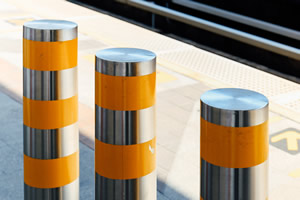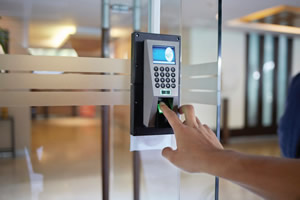The Future of School Security
What Can Schools Learn from America's Busiest Airports?

PHOTO © JAYZ3T
Security is paramount in airports —
charged with leading the continual evolution of public
safety and heading off threats while providing a fair,
seamless experience that doesn’t further intrude on the travel
experience. Similarly, schools are challenged with addressing
heightened security issues including active shooters, gangs and
bullying, while preserving a welcoming, nurturing campus
community. From stronger but less intrusive safety measures and
“shut-down” protocols to juggling varying degrees of clearance in
a complex environment, schools and airports share many of the
same challenges and goals in public security. Corgan’s education
studio is partnering with the designers of the nation’s busiest
airports to study these spaces as living laboratories in public safety
and adapt the latest technologies in passive security measures.
Because threats can come from anyone or anywhere, both
schools and airports must equally and fairly manage a large
throughput of users at several secure entry points while alleviating
fear and stress for students and travelers alike. Complex
environments such as airports present the added challenge of
choreographing the security of a large volume of diverse users,
as well as a variety of functions, including curbside, baggage,
ticketing and airside operations. Likewise, at a large urban school, up to 3,000 students pour onto the campus
within a short window via multiple entry
points and several travel modalities — by
foot, bus, car, bike or, soon, self-driving
cars. Not unlike the passenger mix at most
airports, the typical campus community
welcomes a diverse mix of parents, teachers,
community visitors and students varying in
age, abilities and development —
all expecting a safe, secure campus that
doesn’t feel like a prison.
As schools look to evolve alongside the
changing landscape of security, layered,
ongoing and expanded measures have
required an evolution in how to think of
and define passive security. Schools must
detect and deter threats earlier and at
multiple times and points of the student’s
day to maintain clearance from a growing
number of safety concerns. However, the
added layers of monitoring, scanning
and tracking also requires that these
measures are all but invisible. Airports,
confronted with the same challenge, have
expanded the definition of passive security
to include the growing trend of ambient
technologies and practices embedded
into the environment that, virtually
undetectable, reduce interference in how
humans interact with their environment.
Drawing inspiration from the future of
passive security in airports, schools have a
powerful opportunity to adapt these tools
for the safety of today’s campus.
The Approach
Security and threat detection should
begin as early as possible. Securing the
campus’ approach mirrors aviation
safety designations between “airside”
and “curbside” clearance. Through a
combination of safeguards, the campus is
secured to maintain similar clearance and
potential threats are diverted before they
enter the campus.
In addition to scanners built into
bollards and awnings along the approach
and campus perimeter, new technologies are
making it possible for school administration
to better allocate their resources and
detect threats. Environmental sensors
from airports that measure vehicle and
pedestrian activity can be used at the
parking lot and in lighting not only to add
surveillance but also collect data and better
allocate resources.
Systems are also currently available
that scan and detect possible threats
within a transport vehicle. In aviation,
passengers can have their luggage scanned
and their identification verified as they
make their way to the airport — “clearing”
the traveler before they ever reach the
airport. Similarly, fully automated school
transportation systems are being tested
to reinvent the nearly 100-year-old busing
methods in use today. While this doesn’t
address how everyone arrives on campus,
“pre-screened” bus riders can proceed
onto the campus without added visual
interruption or time.
Environmental Monitoring
Once on the campus, multiple stages
of detection and deterrence that follow
the daily paths and rhythms of students
seamlessly integrate into the environment
for ongoing screening to maintain
“campus-side” clearance.
At an airport in Dubai, entertaining
environments serve as visual spectacles
to alleviate travel anxieties while also
creating a visual distraction from intandem
screening measures. For instance,
a tunnel can be transformed in a virtual
aquarium or a space exploratorium and,
using a system of cameras and biometric
data, can complete screening for large
groups in as a little as 10 seconds. As this
technology becomes more developed, it
is foreseeable that such technology could
be introduced to a school vestibule or
hallway, replacing the metal detector in
scanning high volumes of traffic entering
the building.
The advancement of technologies
also makes it possible to manage large
numbers of people with screening that is
quick, inconspicuous and flexible. Radar
and flooring systems, for example, can
detect concealed weapons and effectively
screen up to one person every five seconds
through a single-entry point. They can
be used for specific events and later be
removed for use in another location.
Once inside the building, real-time
monitoring systems can provide data for
the campus population through existing
cameras — helping identify where best
to position staff, reduce bottlenecks and
improve situational awareness.
Airports are also experimenting with
automated baggage screening, including
small imaging or scanning pods. One day,
this could allow students to drop off a
backpack at the door when they arrive to have
it screened and waiting at their classroom
or provide ongoing screening of lockers and
other storage areas throughout the campus.
Biometrics

PHOTO © SOMPETCH KHANAKORNPRATIP
Technological solutions. In addition to scanners built into bollards and awnings along the approach and campus perimeter, new technologies are
making it possible for school administration to better allocate their resources and detect threats. Face recognition software, for instance, can be used to
register identities, grant clearance, provide an alert when recognized or located within the network or identify and track unauthorized visitors. Retina and
fingerprint scanning complement this technology at specific clearance points, while laser molecular body scanners are in development to simultaneously
scan multiple people to detect traces of explosives or drugs from further distances. Many schools that currently use electronic access card access system
to monitor doors and provide notification of doors that might be propped open, will start to make the switch to fingerprint and retina scanning, which
eliminates the need for cards that easily be lost or stolen.
Most campuses already employ some
sort of badging and background screening
of visitors. However, emerging biometric
technology used in some airports provides
a glimpse into the possibilities of a more
accurate and less intrusive method of
managing access, detecting threats and
mitigating security issues. Face recognition
software, for instance, can be used to
register identities, grant clearance, provide
an alert when recognized or located
within the network or identify and track
unauthorized visitors. Retina and fingerprint
scanning complement this technology at specific clearance points, while laser molecular body scanners are in
development to simultaneously scan multiple people to detect traces
of explosives or drugs from further distances. Many schools that
currently use electronic access card access system to monitor doors
and provide notification of doors that might be propped open, will
start to make the switch to fingerprint and retina scanning, which
eliminates the need for cards that easily be lost or stolen.
Thermal scanning can also be integrated into video cameras to
detect anomalies — identifying those with higher stress levels that
may either be in danger or need additional monitoring.
The advent of robotics and drones augments the potential of
these biometric technologies. The aviation sector, for example, is
exploring various uses for drones modeled after a butterfly with
facial recognition capabilities. Used in schools, these butterfly
drones can track suspicious activity, locate active shooters,
communicate locations and remotely monitor threats. Providing an
extra set of eyes throughout the campus, they can quickly respond
to security issues while providing ambient monitoring that is
approachable, interactive and appropriate for the school campus.
National tragedies, the introduction of cyberbullying and a
growing list of sexual harassment cases have kept school safety in
the spotlight for decades. Similarly, terrorism and drug activity
among several other threats to public safety keep airports in the
headlines and at the forefront of security. While these technologies
do not promise to remove every threat everywhere, nor do they
remove the need for more active, visible interventions, they
present a number of possibilities for districts to appropriately and
thoughtfully consider as they explore the future of school safety —
where the need for stronger security measures is met and balanced
with the need to preserve our human experience in the way we
perceive and respond to the world around us.
This article originally appeared in the School Planning & Management July/August 2019 issue of Spaces4Learning.